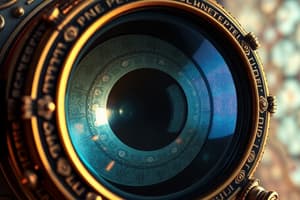Podcast
Questions and Answers
What is the name of the surface that separates two mediums?
What is the name of the surface that separates two mediums?
Diopter
What is the refractive index of air?
What is the refractive index of air?
1.33
What is the name of the law that describes the behavior of light rays at the interface of two mediums?
What is the name of the law that describes the behavior of light rays at the interface of two mediums?
Snell-Descartes law
What is the nature of light?
What is the nature of light?
What is the definition of a diopter that forms a virtual image?
What is the definition of a diopter that forms a virtual image?
What is the name of the eye that has normal optical function?
What is the name of the eye that has normal optical function?
What is the name of the eye that has an abnormal refractive function?
What is the name of the eye that has an abnormal refractive function?
What is the name of the eye that is deprived of its natural lens?
What is the name of the eye that is deprived of its natural lens?
What is the name of the eye that has an artificial lens?
What is the name of the eye that has an artificial lens?
An ametropia is a condition where the eye is unable to focus light correctly on the retina.
An ametropia is a condition where the eye is unable to focus light correctly on the retina.
What is the definition of myopia?
What is the definition of myopia?
What is the name of the point where the myopic eye sees clearly?
What is the name of the point where the myopic eye sees clearly?
What is the formula to calculate the degree of myopia (DM)?
What is the formula to calculate the degree of myopia (DM)?
The punctum remotum (PR) is located farther away from the eye in a myopic individual than in an emmetropic individual.
The punctum remotum (PR) is located farther away from the eye in a myopic individual than in an emmetropic individual.
What type of lens corrects myopia?
What type of lens corrects myopia?
Hyperopia is corrected by a converging lens.
Hyperopia is corrected by a converging lens.
A hyperopic eye has a stronger refractive power than an emmetropic eye.
A hyperopic eye has a stronger refractive power than an emmetropic eye.
Astigmatism is a type of ametropia that affects all eyes equally.
Astigmatism is a type of ametropia that affects all eyes equally.
Astigmatism occurs only in one eye.
Astigmatism occurs only in one eye.
What is the primary reason for astigmatism?
What is the primary reason for astigmatism?
What is the type of corrective lens used for astigmatism?
What is the type of corrective lens used for astigmatism?
Astigmatism occurs only when the cornea is not spherical.
Astigmatism occurs only when the cornea is not spherical.
Astigmatism is a common eye condition that can often be corrected with eyeglasses or contact lenses.
Astigmatism is a common eye condition that can often be corrected with eyeglasses or contact lenses.
Astigmatism is a leading cause of blindness.
Astigmatism is a leading cause of blindness.
What causes irregular astigmatism?
What causes irregular astigmatism?
Irregular astigmatism is typically corrected with eyeglasses.
Irregular astigmatism is typically corrected with eyeglasses.
What is the main treatment option for irregular astigmatism?
What is the main treatment option for irregular astigmatism?
Astigmatism is a type of refractive error that can affect a person's vision at all distances.
Astigmatism is a type of refractive error that can affect a person's vision at all distances.
Flashcards
Dioptre
Dioptre
The surface where two different mediums meet, allowing light rays to bend according to Descartes' laws.
Natural Light
Natural Light
A combination of many electromagnetic waves with varying wavelengths.
Ray of Light
Ray of Light
A straight line representing the path of light propagation in a transparent and uniform medium.
Stigmatic Optical System
Stigmatic Optical System
Signup and view all the flashcards
Astigmatic Optical System
Astigmatic Optical System
Signup and view all the flashcards
Power of a Dioptre
Power of a Dioptre
Signup and view all the flashcards
The Image is at Infinity
The Image is at Infinity
Signup and view all the flashcards
Emmetropic Eye
Emmetropic Eye
Signup and view all the flashcards
Ametropic Eye
Ametropic Eye
Signup and view all the flashcards
Phakic Eye
Phakic Eye
Signup and view all the flashcards
Pseudophakic Eye
Pseudophakic Eye
Signup and view all the flashcards
Ametropia
Ametropia
Signup and view all the flashcards
Spherical Ametropia
Spherical Ametropia
Signup and view all the flashcards
Astigmatism
Astigmatism
Signup and view all the flashcards
Myopia
Myopia
Signup and view all the flashcards
Axial Myopia
Axial Myopia
Signup and view all the flashcards
Curvature Myopia
Curvature Myopia
Signup and view all the flashcards
Index Myopia
Index Myopia
Signup and view all the flashcards
Degree of Myopia
Degree of Myopia
Signup and view all the flashcards
Accommodation
Accommodation
Signup and view all the flashcards
Correction of Myopia
Correction of Myopia
Signup and view all the flashcards
Hyperopia
Hyperopia
Signup and view all the flashcards
Axial Hyperopia
Axial Hyperopia
Signup and view all the flashcards
Curvature Hyperopia
Curvature Hyperopia
Signup and view all the flashcards
Index Hyperopia
Index Hyperopia
Signup and view all the flashcards
Degree of Hyperopia
Degree of Hyperopia
Signup and view all the flashcards
Accommodation
Accommodation
Signup and view all the flashcards
Correction of Hyperopia
Correction of Hyperopia
Signup and view all the flashcards
Astigmatism
Astigmatism
Signup and view all the flashcards
Regular Astigmatism
Regular Astigmatism
Signup and view all the flashcards
Irregular Astigmatism
Irregular Astigmatism
Signup and view all the flashcards
Study Notes
Dioptric Ocular
- A diopter separates two mediums
- Light rays follow the laws of reflection and refraction
- Natural light is a superposition of electromagnetic waves with various wavelengths
- Light rays travel in straight lines in a uniform medium
- Light rays change direction when passing through different mediums
- Light rays are bent when passing from one medium to another (refraction)
- The bending of light depends on the refractive indices of the mediums
- The power of a lens is measured in diopters (D)
- The power of a lens is the reciprocal of its focal length (in meters)
Lens Power and Diopters
- The power of a lens is calculated by the formula P = 1/f , where P is the power in diopters and f is the focal length in meters
- A positive power indicates a converging lens (convex), while a negative power indicates a diverging lens (concave)
- A converging lens focuses parallel light rays to a single point
- A diverging lens spreads out parallel light rays
Eye Defects
- Myopia (Nearsightedness): The eyeball is too long, causing the image to focus in front of the retina
- Hyperopia (Farsightedness): The eyeball is too short, causing the image to focus behind the retina
- Astigmatism: The cornea or lens is not perfectly spherical, causing light rays to focus at different points on the retina
- Various types of astigmatism are distinguished by the relative positions of the foci
Eye Correction
- Corrective lenses (glasses or contacts) are used to adjust the focus of the light, bringing the image to focus on the retina
- The appropriate lens strength is calculated to compensate for the eye's refractive error
- The correction for astigmatism involves cylindrical lenses
Additional Notes
- The power of a lens is a measure of its ability to focus light
- The focal length is the distance from the lens to the focal point where parallel light rays converge
- Refractive errors like myopia and hyperopia are common eye conditions
- Different types of eye defects can be corrected with appropriate lenses
Studying That Suits You
Use AI to generate personalized quizzes and flashcards to suit your learning preferences.




